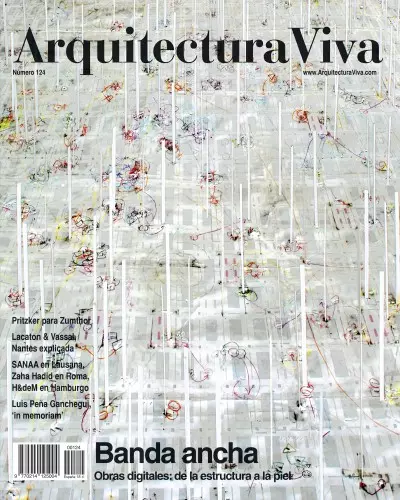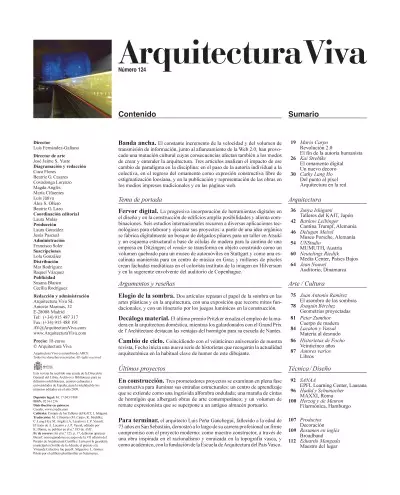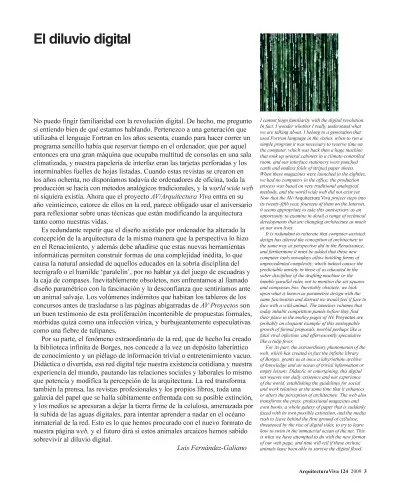Synopses
Broadband. The constant increase of the speed and volume of information transmission, along with the establishment of the Web 2.0, have spawned a cultural mutation the consequences of which also have an influence on the ways of generating and understanding architecture. Three articles analyze the impact of that change of paradigm in the field: in the transition from individual to collective authorship, in the return to ornament as built expression free from the stigma of Loos, and in the publication and representation of works in the traditional printed media and on websites.
Contents
Mario Carpo
Revolution 2.0
The End of Authorship
Kai Strehlke
Digital Ornament
A New Decorum
Cathy Lang Ho
From Dot to Pixel
Architecture on the Web
Digital Fervor. The progressive incorporation of digital tools both in the design and in the construction of buildings broadens possibilities and inspires new combinations. Six architectural offices resort to different technological applications to develop and materialize their projects: an organic idea is taken as starting point to digitally manufacture a grove of svelte columns for a work-shop in Atsuki and a structural scheme based on wood cells for a company cafeteria in Ditzingen; renderings become built objects taking the form of a broken volume to house an automobile museum in Stuttgart and of a mannerist staircase to contain a music center in Graz; and millions of pixels generate interactive facades in the colorist media center in Hilversum and in the revealing enclosure of the Copenhagen auditorium.
Junya Ishigami
KAIT Workshops, Japan
Barkow Leibinger
Trumpf Canteen, Germany
Delugan Meissl
Porsche Museum, Germany
UNStudio
MUMUTH, Austria
Neutelings Riedijk
Media Center, The Netherlands
Jean Nouvel
Auditorium, Denmark
Views and Reviews
In Praise of Shadows. Two articles review the role of the shadow in the arts and in architecture, with an exhibition that covers foundational myths, and with a run-through of the effects of light in construction.
Art / Culture
Juan Antonio Ramírez
The Wonder of Shadows
Joaquín Bérchez
Cast Geometries
Material Decalogue. The latest laureate of the Pritzker Prize extols the use of wood in domestic architecture, while the winners of the Grand Prix de l’Architecture highlight the advantages of concrete in their school in Nantes.
Peter Zumthor
Body of Wood
Lacaton & Vassal
Bare Matter
Change of Cycle. Coinciding with the twenty-fifth anniversary of our magazine, Focho starts a new series of cartoons that will reflect the current state of architectural affairs in this draftsman’s usual humorous key.
Focho’s Cartoon
Twenty-Five Years
Various Authors
BooksRecent Projects
In Progress. The analysis of three major projects at the peak of their construction phase allows to shed light on their structural cores: a learning center that spreads like a weightless undulating carpet; a tangle of concrete ribbons that will custody works of contemporary art; and a volume of expressionistic profile that is placed atop an existing warehouse in the port.
Technique / Style
SANAA
EPFL Center, Lausanne
Hadid & Schumacher
MAXXI, Rome
Herzog & de Meuron
Philharmonic Hall, Hamburg
To close, the architect Luis Peña Ganchegui passed away in San Sebastián at 73, leaving behind a professional career in which he showed a firm commitment with modernity: as master builder, through an oeuvre inspired by rationalism and deeply rooted in the Basque topography, and as an academic, with the foundation of the Basque Country School of Architecture.
Products
Interior Design
English Summary
Broadband
Eduardo Mangada
Master of the Place
Luis Fernández-Galiano
The Digital Deluge
I cannot feign familiarity with the digital revolution. In fact, I wonder whether I really understand what we are talking about. I belong to a generation that used Fortran language in the sixties, when to run a simple program it was necessary to reserve time on the computer, which was back then a huge machine that took up several cabinets in a climate-controlled room, and our interface stationery were punched cards and endless folds of striped paper sheets. When these magazines were launched in the eighties, we had no computers in the office, the production process was based on very traditional analogical methods, and the world wide web did not exist yet. Now that the AV/Arquitectura Viva project steps into its twenty-fifth year, fourteen of them on the Internet, it seems appropriate to take this anniversary as an opportunity to examine in detail a range of technical developments that are changing architecture as much as our own lives.
It is redundant to reiterate that computer-assisted design has altered the conception of architecture in the same way as perspective did in the Renaissance, and furthermore it must be added that these new computer tools nowadays allow building forms of unprecedented complexity, which indeed causes the predictable anxiety in those of us educated in the sober discipline of the drafting machine or the humble parallel ruler, not to mention the set squares and compasses box. Inevitably obsolete, we look upon what is known as parametric design with the same fascination and distrust we would feel if face to face with a wild animal. The tameless volumes that today inhabit competition panels before they find their place in the motley pages of AV Proyectos are probably an eloquent example of this unstoppable growth of formal proposals, morbid perhaps like a fatal viral infection, and effervescently speculative like a tulip fever.
For its part, the extraordinary phenomenon of the web, which has created in fact the infinite library of Borges, grants us at once a labyrinthine archive of knowledge and an ocean of trivial information or empty leisure. Didactic or entertaining, this digital net weaves our daily existence and our experience of the world, establishing the guidelines for social and work relations at the same time that it enhances or alters the perception of architecture. The web also transforms the press, professional magazines and even books, a whole galaxy of paper that is suddenly faced with its own possible extinction, and the media rush to leave behind the firm ground of cellulose, threatened by the rise of digital tides, to try to learn how to swim in the immaterial ocean of the net. This is what we have attempted to do with the new format of our web page, and time will tell if these archaic animals have been able to survive the digital flood.








